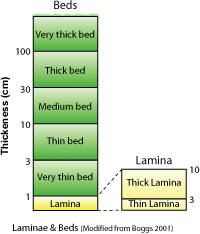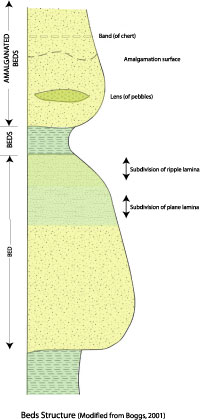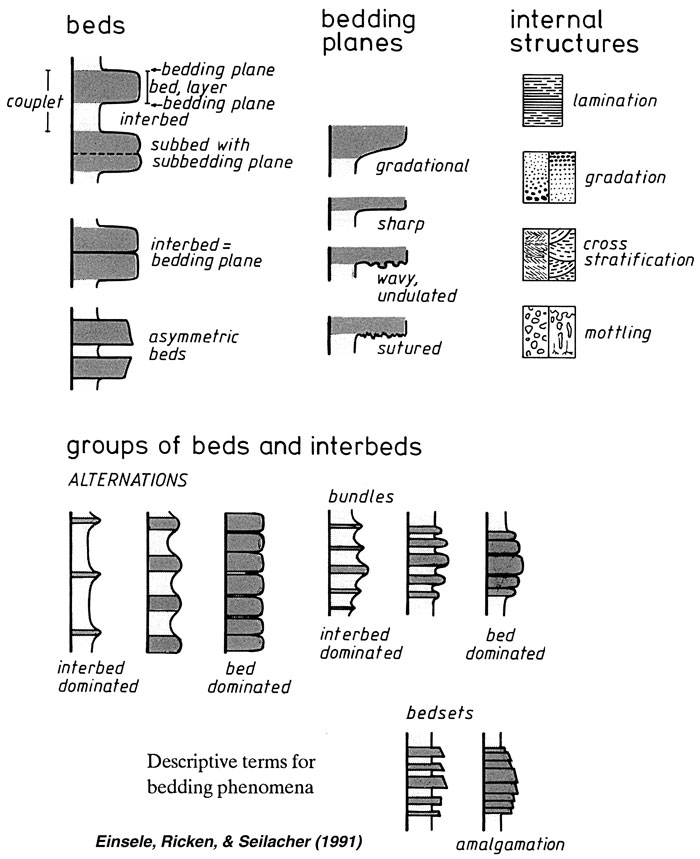|
bedding plane
bedset
coastal trajectory
depositional surface
lamina
laminaset
progradation
Niels Steensen
stacking patterns
strata

retrogradation
William Smith
|
These are commonly layers of sedimentary rock separated by breaks called bedding planes. The sedimentary "bed" is the basic unit,or fundamental building block of stratigraphy (Campbell, 1967). The lithologic composition of beds, their geometry, their trajectory, stacking patterns and hierarchies are used to interpret their depositional setting. Beds may signal a global process that acted over ten's of thousand of years or may be very local products of "events" that acted over a matter of hours or days (Einsele et al, 1991).
 

In the 16th century Niels Steensen (1669) recognized that sedimentary rocks were:
• Formed of layers or strata
• These over lie on another in the order they accumulated
• Were close to horizontal at deposition
• Have a lateral continuity that pinches out at the margin of a depositional basin.
Steno, as he was known in the Medici Court, made these critical geological observations in "De solido intra solidum naturaliter contento dissertationis prodromus". He inspired the use of bedding to map and interpret sedimentary rocks. As a result Jean-Etienne Guettard used beds, as did Georges Cuvier, in their mapping in France, and William Smith (1815) when mapping the sedimentary strata of England on the basis of the lithology, "erosional" breaks, and the sequential order the fossil content of beds. Undoubtedly the recognition of beds must have had earlier origins, so even in the 5th century BC contemporaries of Pythagoras were aware of layered accumulation of sediment found in the exposed portions of the Earth's crust (Lyell, 1830).
In 1953 McKee and Weir defined a ‘bed' as a laterally traceable, three-dimensional rock body of relatively uniform physical, chemical/mineralogical, and biological composition distinguishable from rock above and below. bed size was seen to range from very thin-bedded 1 cm to very thick-bedded, 1 m (McKee and Weir, 1953, Ingram, 1954).
Most sedimentary stratigraphers probably concur with McKee and Weir's (1953) definition and like Boggs (2001) attribute the origin of the thickness and composition of individual beds to nearly constant physical, chemical, and biological conditions in the depositional setting. However a critical property of beds, whose origins are often enigmatic, is the bedding plane that separates beds from each other with sharply defined upper and lower surfaces
So a bed can be considered to be a relatively conformable succession of genetically related sedimentary materials, laminae or laminasets bounded by surfaces (called bedding planes or surfaces) of erosion, non-deposition or their correlative conformities. boundaries form rapidly (minutes to years) and separate all younger strata from all other strata over the extent of the surface. The time represented by bedding planes probably greater than time represented by beds (AAPG Methods in Exploration 7, 1990). The lateral extent of a bed across a terrain may capture the trajectory that sedimentary fill took during for example coastal progradation or retrogradation, hence capturing coastal trajectory.
Useful References
Boggs, S. Jr., 2001, Principles of sedimentology and stratigraphy 3rd. ed. Prentice-Hall, Upper Saddle River, New Jersey: 726 p.
Campbell C. V., 1979, Lamiae, laminaset, bed and bedset: Sedimentology v8, p7-26
Ingram, R.L., 1954, Terminology for the thickness of stratification and parting units in sedimentary rocks. Geol. Soc. Bulletin, 65: 937-938.
Einsele G., Ricken W., and Seilacher A., (editors), 1991, "cycles and events in stratigraphy", Springer-Verlag, Berlin, Heidelberg, New York 1991. 955p.
Lyell, C., 1830, Principles of Geology volume 1, pp 511
McKee, E.D., and Weir, G.W., 1953, Terminology for stratification and cross-stratification in sedimentary rocks. Geol. Soc. America Bulletin, 64(4): 381-389.
Schlager, W., 2004, fractal nature of stratigraphic sequences. Geology, 32(3): 185-188.
Steno, N, (alias Nils Steno, Niels Stensen, and Nicolai Stenonis) 1669, De Solido Intra Solidium Naturaliter Contento Dissertationis Prodromus: Florence, Italy, Library of Grand Duke Ferdinand II, - V. iv, 131 p. English version: Stensen, Niels 1671, The
prodromus to a dissertation concerning solids naturally contained within solids. J. Winter, London, 112 p.
|